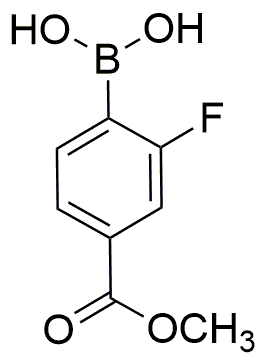2-Fluoro-4-(methoxycarbonyl)phenylboronic acid is widely utilized in research focused on:
- Pharmaceutical Development: This compound serves as a key intermediate in the synthesis of various pharmaceuticals, particularly in the development of anti-cancer agents. Its unique boronic acid functionality allows for selective reactions that enhance drug efficacy.
- Organic Synthesis: It is employed in cross-coupling reactions, such as Suzuki-Miyaura coupling, which is essential for forming carbon-carbon bonds. This application is crucial in the creation of complex organic molecules used in materials science and medicinal chemistry.
- Bioconjugation: The compound can be used to attach biomolecules to surfaces or other molecules, facilitating the development of targeted drug delivery systems and diagnostic tools in biomedicine.
- Material Science: Its properties make it suitable for creating functionalized polymers and materials, which can be used in electronics and sensors, providing enhanced performance compared to traditional materials.
- Research in Catalysis: The compound acts as a catalyst in various chemical reactions, improving reaction rates and selectivity, which is beneficial for researchers looking to optimize synthetic pathways.
General Information
Properties
Safety and Regulations
Applications
2-Fluoro-4-(methoxycarbonyl)phenylboronic acid is widely utilized in research focused on:
- Pharmaceutical Development: This compound serves as a key intermediate in the synthesis of various pharmaceuticals, particularly in the development of anti-cancer agents. Its unique boronic acid functionality allows for selective reactions that enhance drug efficacy.
- Organic Synthesis: It is employed in cross-coupling reactions, such as Suzuki-Miyaura coupling, which is essential for forming carbon-carbon bonds. This application is crucial in the creation of complex organic molecules used in materials science and medicinal chemistry.
- Bioconjugation: The compound can be used to attach biomolecules to surfaces or other molecules, facilitating the development of targeted drug delivery systems and diagnostic tools in biomedicine.
- Material Science: Its properties make it suitable for creating functionalized polymers and materials, which can be used in electronics and sensors, providing enhanced performance compared to traditional materials.
- Research in Catalysis: The compound acts as a catalyst in various chemical reactions, improving reaction rates and selectivity, which is beneficial for researchers looking to optimize synthetic pathways.
Documents
Safety Data Sheets (SDS)
The SDS provides comprehensive safety information on handling, storage, and disposal of the product.
Product Specification (PS)
The PS provides a comprehensive breakdown of the product’s properties, including chemical composition, physical state, purity, and storage requirements. It also details acceptable quality ranges and the product's intended applications.
Certificates of Analysis (COA)
Search for Certificates of Analysis (COA) by entering the products Lot Number. Lot and Batch Numbers can be found on a product’s label following the words ‘Lot’ or ‘Batch’.
*Catalog Number
*Lot Number
Certificates Of Origin (COO)
This COO confirms the country where the product was manufactured, and also details the materials and components used in it and whether it is derived from natural, synthetic, or other specific sources. This certificate may be required for customs, trade, and regulatory compliance.
*Catalog Number
*Lot Number
Safety Data Sheets (SDS)
The SDS provides comprehensive safety information on handling, storage, and disposal of the product.
DownloadProduct Specification (PS)
The PS provides a comprehensive breakdown of the product’s properties, including chemical composition, physical state, purity, and storage requirements. It also details acceptable quality ranges and the product's intended applications.
DownloadCertificates of Analysis (COA)
Search for Certificates of Analysis (COA) by entering the products Lot Number. Lot and Batch Numbers can be found on a product’s label following the words ‘Lot’ or ‘Batch’.
*Catalog Number
*Lot Number
Certificates Of Origin (COO)
This COO confirms the country where the product was manufactured, and also details the materials and components used in it and whether it is derived from natural, synthetic, or other specific sources. This certificate may be required for customs, trade, and regulatory compliance.


